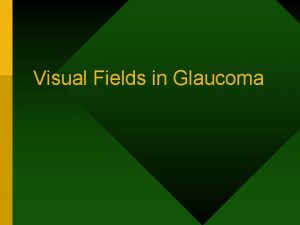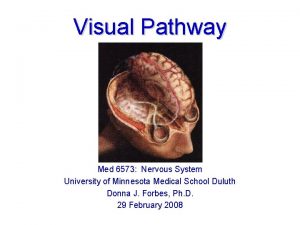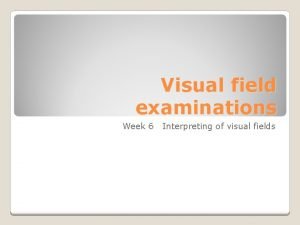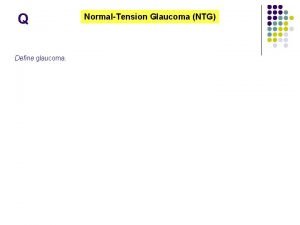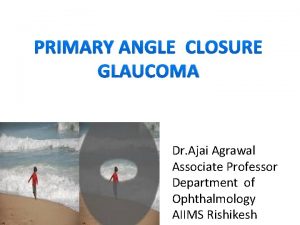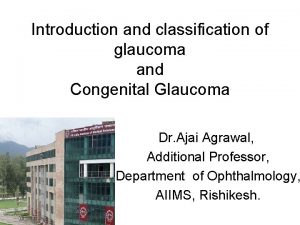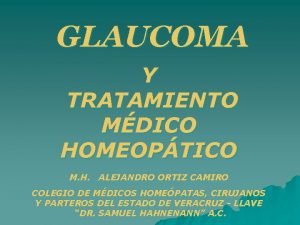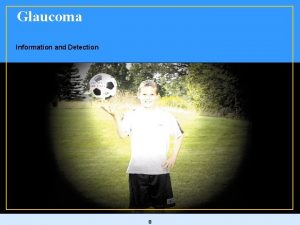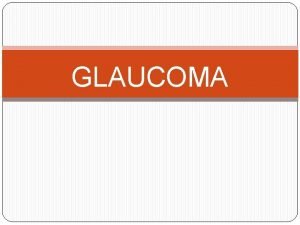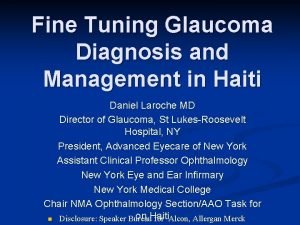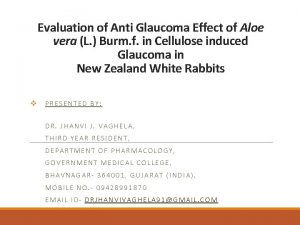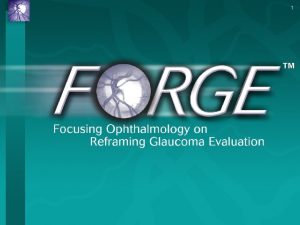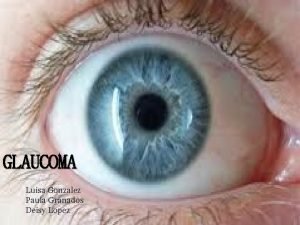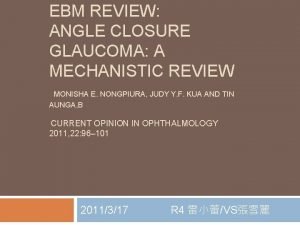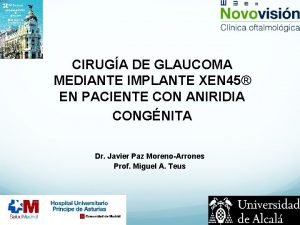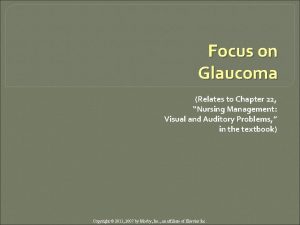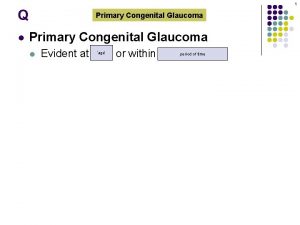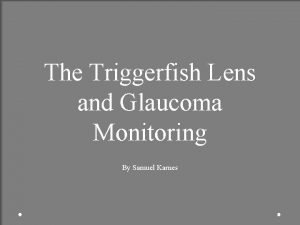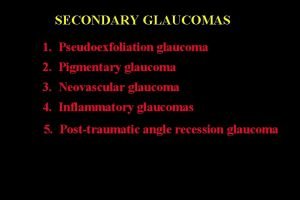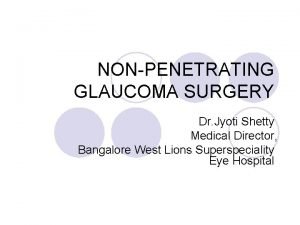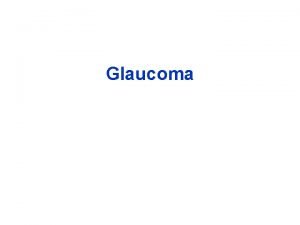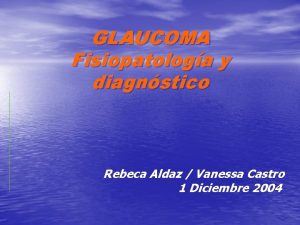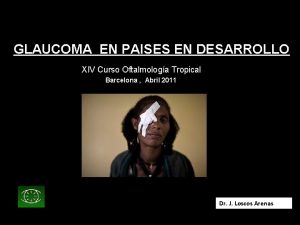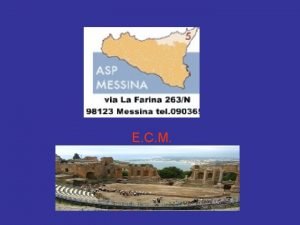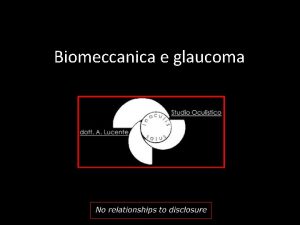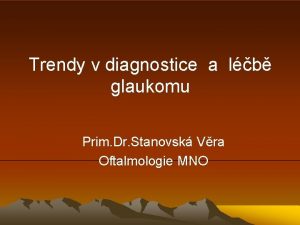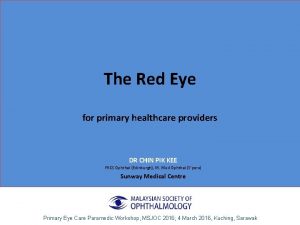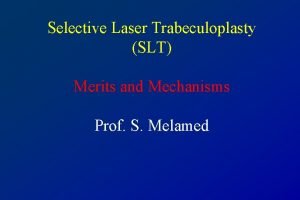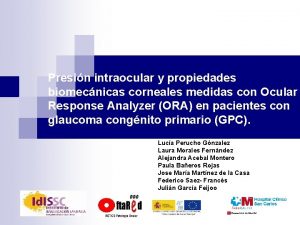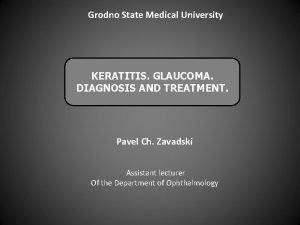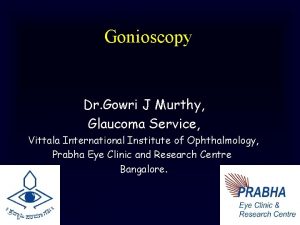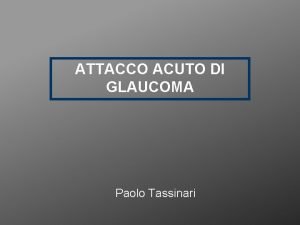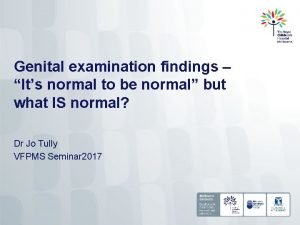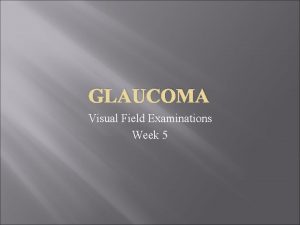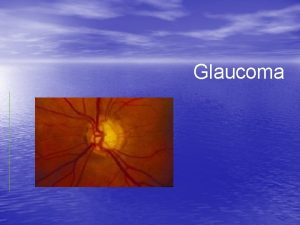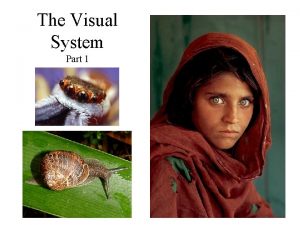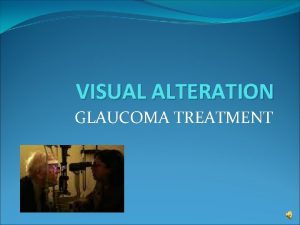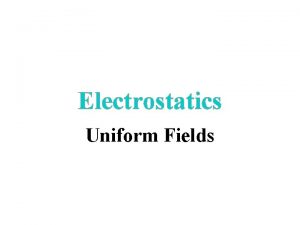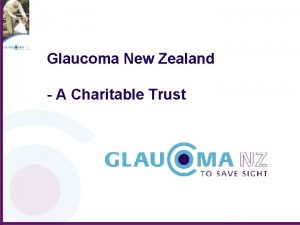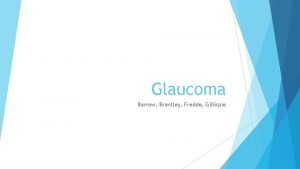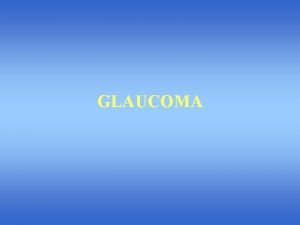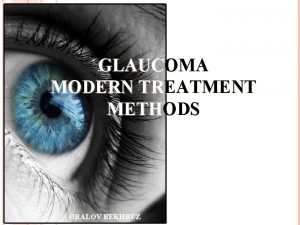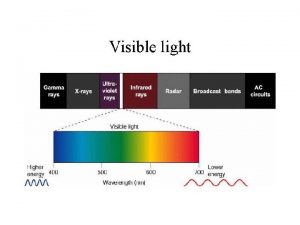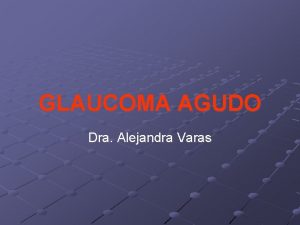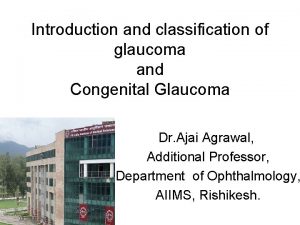Visual Fields in Glaucoma THE NORMAL VISUAL FIELD






























































- Slides: 62

Visual Fields in Glaucoma

THE NORMAL VISUAL FIELD • The field of vision is defined as the area that is perceived simultaneously by a fixating eye. The limits of the normal field of vision are 60° into the superior field, 75° into the inferior field, 110° temporally, and 60° nasally. Traquair, in his classic thesis, described an island of vision in the sea of darkness. The island represents the perceived field of vision, and the sea of darkness is the surrounding areas that are not seen. In the light-adapted state, the island of vision has a steep central peak that corresponds to the fovea, the area of greatest retinal sensitivity.

THE NORMAL VISUAL FIELD

THE NORMAL VISUAL FIELD • The contour of the island of vision relates to both the anatomy of the visual system and the level of retinal adaptation. The highest concentration of cones is in the fovea, and most of these cones project to their own ganglion ceil. This one-to-one ratio between foveal cone and ganglion cell results in maximal resolution in the fovea.

KINETIC PERIMETRY • In kinetic perimetry, a stimulus is moved from a nonseeing area of the visual field to a seeing area along a set meridian. The procedure is repeated with the use of the same stimulus along other meridians, usually spaced every 15°. • In kinetic perimetry, one attempts to find locations in the visual field of equal retinal sensitivity. By joining these areas of equal sensitivity, an isopter is defined. • The luminance and the size of the target is changed to plot other isopters. In kinetic perimetry, the island of vision is approached horizontally. Isopters can be considered the outline of horizontal slices of the island of vision.

STATIC PERIMETRY • In static perimetry, the size and location of the test target remain constant. The retinal sensitivity at a specific location is determined by varying the brightness of the test target. The shape of the island is defined by repeating the threshold measurement at various locations in the field of vision.

STATIC PERIMETRY

MANUAL PERIMETRY: THE GOLDMANN VISUAL FIELD • The Goldmann perimeter* is the most widely used instrument for manual perimetry. It is a calibrated bowl projection instrument with a background intensity of 3 1. 5 apostilbs (asb), which is well within the photopic range. The size and intensity of targets can be varied to plot different isopters kinetically and determine local static thresholds.

MANUAL PERIMETRY: THE GOLDMANN VISUAL FIELD • The stimuli used to plot an isopter are identified by a Roman numeral, a number, and a letter. The Roman numeral represents the size of the object, from Goldmann size 0 (1/16 mm 2) to Goldmann size V (64 mm 2). • Each size increment equals a twofold increase in diameter and a fourfold increase in area.

GOLDMANN VISUAL FIELD

GOLDMANN VISUAL FIELD • The number and letter represent the intensity of the stimulus. • A change of one number represents a 5 -db (0. 5 log unit) change in intensity, and each letter represents a 1 -db (0. 1 log unit) change in intensity. • The dynamic range of the Goldmann perimeter from the smallest/dimmest target (01 a) to the largest/brightest target (V 4 e) is greater than 4 log units, or a 10, 000 -fold change.

GOLDMANN VISUAL FIELD

GOLDMANN VISUAL FIELD • The number and letter represent the intensity of the stimulus. A change of one number represents a 5 -db (0. 5 log unit) change in intensity, and each letter represents a 1 -db (0. 1 log unit) change in intensity. • The dynamic range of the Goldmann perimeter from the smallest/dimmest target (01 a) to the largest/brightest target (V 4 e) is greater than 4 log units, or a 10, 000 -fold change.

GOLDMANN VISUAL FIELD • Isopters in which the sum of the Roman numeral (size) and number (intensity) are equal can be considered equivalent. For example, the I 4 e isopter is roughly equivalent to the II 3 e isopter. A change of one number of intensity is roughly equivalent to a change of one Roman numeral of size. • The equivalent isopter combination with the smallest target size usually is preferred because detection of isopter edges is more accurate with smaller targets. • One usually starts by plotting small targets with dim intensity (I 1 e) and then increasing the intensity of the target until it is maximal before increasing the size of the target. The usual progression then is I 1 e (ARW 1) I 2 e (ARW 1) I 3 e (ARW 1) I 4 e (ARW 1) III 4 e (ARW 1) IV 4 e (ARW 1) V 4 e

GOLDMANN VISUAL FIELD

Static suprathreshold and threshold testing. • In addition to plotting isopters kinetically, static suprathreshold and threshold testing can be performed manually. Once an isopter is plotted, the stimulus used to plot the isopter is used to statically test within the isopter to look for localized defects. In this way, it acts as a suprathreshold stimulus. Static thresholds also can be determined along set meridians to obtain profile plots of the visual field, but like any multiple thresholding task, it is time consuming.

Comparison of static and kinetic perimetry to detect shallow scotomas

AUTOMATED PERIMETRY • The introduction of computers and automation heralded a new era in perimetric testing. Static testing can be performed in an objective and standardized fashion with minimal perimetrist bias. A quantitative representation of the visual field can be obtained more rapidly than with manual testing. The computer allows stimuli to be presented in a pseudorandom, unpredictable fashion. Patients do not know where the next stimulus will appear, so fixation is improved, thereby increasing the reliability of the test. Random presentations also increase the speed with which perimetry can be performed by bypassing the problem of local retinal adaptation, which requires a 2 -second interval between stimuli if adjacent locations are tested.

THE DIFFERENTIAL LIGHT THRESHOLD • Static computerized perimetry measures retinal sensitivity at predetermined locations in the visual field. These perimeters measure the ability of the eye to detect a difference in contrast between a test target and the background luminance. The differential light threshold is designated as the dimmest target seen 50% of the time. Suprathreshold stimuli are brighter than threshold stimuli, and they will be seen more than 50% of the time. Infrathreshold stimuli are dimmer than threshold stimuli, and they will be seen less than 50% of the time.

THE DIFFERENTIAL LIGHT THRESHOLD • Threshold at a specific retinal location can be measured directly from a frequency-of-seeing curve. The frequency-of-seeing curve is generated by testing one retinal location multiple times with different stimulus intensities. The frequency-of-seeing curve is the graph of the percentage of stimuli seen at each intensity level. Threshold is read off the graph at the 50 th percentlie

Frequency of seeing curve

Frequency of seeing curve • Stimuli of varying intensities are presented multiple times at one retinal location. Threshold is designated as the dimmest stimulus seen 50% of the time.

Comparison of static and kinetic perimetry to detect shallow scotomas • Comparison of static and kinetic perimetry to detect shallow scotomas and determine the slope of the scotoma. A. Kinetic evaluation can clearly outline the normal visual field. B. Kinetic perimetry may miss shallow scotomas and poorly define the flat slope seen nasally. C, The edge of steeply sloped scotomas may be identified easily with kinetic perimetry, but the steepness of the slope may not be appreciated. D. and E. Static perimetry readily detects shallow scotomas and can define the slope of both shallow and steep scotomas. (Aulhorn E, Harms H: Early visual field defects in glaucoma. In Leydecker W [ed]: Glaucoma Symposium, Basel, Switzerland, S Karger, AG, 1966)

• It is impractical to perform frequency-of-seeing curves at the large number of locations required to assess the visual field accurately for glaucomatous damage. Therefore, a staircase, or bracketing, strategy is used to estimate threshold. Most commonly, a 4 -2 algorithm is employed. • Testing starts with either a suprathreshold or an infrathreshold stimulus. For a suprathreshold stimulus, the intensity of the stimulus is decreased in 4 -db steps until the stimulus is no longer seen (threshold is crossed). Threshold is crossed a second time by increasing the stimulus intensity in 2 -db steps until the stimulus is seen again. • The Octopus perimeter estimates threshold as the average of the last seen and unseen stimulus intensities. • The Humphrey perimeter uses the intensity of the last seen

The 4 -2 bracketing strategy to determine threshold. • The 4 -2 bracketing strategy to determine threshold. The stimulus intensity is varied so that threshold is crossed twice, first using 4 -db steps and then 2 -db steps. In this example, the initial stimulus presented was seen. • The stimulus intensity was decreased by 4 db. The second stimulus also was seen, so the intensity again was decreased by 4 db. The third stimulus crossed the threshold (first crossing) and was not seen. The stimulus intensity was increased by 2 db. • The fourth stimulus was not seen, so the intensity was increased by 2 db. The fifth stimulus crossed the threshold (second crossing) and was seen. Threshold is either the intensity of the last seen stimulus (HFA) or the average of the last seen and unseen stimulus (Octopus). The profile of the hill of vision is represented by the threshold at each location.

The 4 -2 bracketing strategy to determine threshold.

APOSTILBS AND DECIBELS • In perimetry, the luminance of test targets is measured in apostilbs. An apostilb is an absolute unit of luminance and is equal to 0. 3183 candela/m 2, or 0. 1 mililambert. • The decibel scale is a relative scale created by the manufacturers of automated perimeters to measure the sensitivity of the island of vision. It is an inverted logarithmic scale. Zero decibels is set as the brightest stimulus that the perimeter can produce. The decibel scale is not standardized because the maximal luminance varies between instruments.

APOSTILBS AND DECIBELS

SENSITIVITY VERSUS THRESHOLD • As one ascends the hill of vision toward the fovea, the sensitivity of the retina increases, dimmer targets will become visible, and the brightness of the target at threshold will decrease. Therefore, as retinal sensitivity increases, the differential light threshold measured in apostilbs decreases. • This inverse relationship between retinal sensitivity and thresholds true throughout most of visual psychophysics. In automated perimetry, however, threshold is recorded in the inverted decibel scale, and dimmer targets have higher decibel values. • Therefore, threshold in decibels is directly proportional to retinal sensitivity.

GLAUCOMATOUS VISUAL FIELD DEFECTS • Any clinically or statistically significant deviation from the normal shape of the hill of vision can be considered a visual field defect. In glaucoma, these defects are either diffuse depressions of the visual field or localized defects that conform to nerve fiber bundle patterns.

DIFFUSE DEPRESSION • Diffuse depression of the visual field results from an overall or widespread sinking of the island of vision and may reflect diffuse loss of nerve fibers of the retina. Diffuse depression is a nonspecific sign that can be caused by many etiologies other than glaucoma. • By far the most common reason for a diffuse depression is lens opacity. Other factors include other media opacities, miosis, improper refraction, patient fatigue, inattentiveness or inexperience with the examination, ocular anomalies, and age. It is difficult to attribute diffuse depression specifically to a glaucomatous process.

DIFFUSE DEPRESSION • In manual perimetry, diffuse depression is manifested by contraction of the isopters. The isopters retain their normal contour. The most central isopters may disappear entirely as the peak of the island of vision sinks.

DIFFUSE DEPRESSION • n automated perimetry, diffuse depression results in relative defects across the entire visual field. • Early diffuse depression often is difficult to detect because thresholds may remain within the normal range, but they may be depressed from previous examinations or the baseline status.

DIFFUSE DEPRESSION

DIFFUSE DEPRESSION

LOCALIZED NERVE FIBER BUNDLE DEFECTS • Localized visual field defects in glaucoma result from damage to the retinal nerve fiber bundles. Because of the unique anatomy of the retinal nerve fiber layer, axonal damage causes characteristic patterns of visual field damage.

LOCALIZED NERVE FIBER BUNDLE DEFECTS

Nerve Fiber Bundle Defects • The superior and inferior poles of the optic nerve head are most vulnerable to glaucomatous damage. It has been postulated that these areas may be watershed areas at the junction of the vascular supply from adjacent ciliary vessels. • Ultrastructural examination of the lamina cribrosa shows that the pores in the superotemporal and inferotemporal areas are larger. The large pores may make these regions more vulnerable to compression.

PARACENTRAL DEFECTS • PARACENTRAL DEFECTS. Circumscribed paracentral defects are an early sign of localized glaucomatous damage. The defects may be absolute when first discovered, or they may have deep nuclei surrounded by areas of less dense involvement. The dense nuclei often are numerous along the course of the nerve fiber bundle

PARACENTRAL DEFECTS

ARCUATE SCOTOMAS • More advanced loss of arcuate nerve fibers leads to a scotoma that starts at or near the blind spot, arches around the point of fixation, and terminates abruptly at the nasal horizontal meridian. • An arcuate scotoma may be relative or absolute. • In the temporal portion of the field, it is narrow because all of the nerve fiber bundles converge onto the optic nerve. • The scotoma spreads out on the nasal side and may be very wide along the horizontal meridian.

ARCUATE SCOTOMAS

NASAL STEP DEFECTS • Because of the anatomy of the horizontal raphe, all complete arcuate scotomas end at the nasal horizontal meridian. A steplike defect along the horizontal meridian results from asymmetric loss of nerve fiber bundles in the superior and inferior hemifields. • Nasal step defects may be evident in some isopters but not in others, depending on which nerve fiber bundles are damaged. The width of the nasal step also varies. Nasal steps frequently occur in association with arcuate and paracentral scotomas, but a nasal step also may occur in isolation. • Approximately 7% of initial visual field defects are peripheral nasal step defects.

TEMPORAL WEDGESHAPED DEFECTS • . Damage to nerve fibers on the nasal side of the optic disc may result in temporal wedgeshaped defects. These defects are much less common than defects in the arcuate distribution. Occasionally, they are seen as the sole visual field defect. • Temporal wedge defects do not respect the horizontal meridian.

TEMPORAL WEDGESHAPED DEFECTS

EARLY VISUAL FIELD DEFECTS • Initial localized visual field defects may be either relative or absolute. In 35 eyes with previously normal visual fields, Werner and Drance 15 found that the earliest defects were paracentral scotomas with a nasal step (51%), isolated paracentral defects (26%), isolated nasal steps (20%), and sector defects (3%). • Hart and Beckerfound the following initial visual field defects in 98 eyes: nasal steps (54%), paracentral or arcuate scotomas (41%), arcuate blind spot enlargement (30%), isolated arcuate scotomas separated from the blind spot (20%), and temporal defects (3%).

BLIND SPOT CHANGES • Enlargement • Vertical elongation of the blind spot may occur with the development of a Siedel scotoma, an early arcuate defect that connects with the blind spot. Peripapillary atrophy, which frequently accompanies glaucomatous damage, particularly in elderly patients, also may cause enlargement of the blind spot. • Baring of the blind spot may be physiologic or pathologic. Physiologic baring of the blind spot is an artifact of kinetic perimetry. The inferior retina is less sensitive than the superior retina, so an isopter plotted at threshold in the inferior central retina may result in superior baring of the blind spot. Physiologic baring of the blind spot usually is confined to a single central isopter in the superior visual field

Physiologic superior baring of the blind spot usually is limited to a single central isopter.

A visual field exhibiting end-stage defects. Only a small central island a temporal island of vision remain.

Differential Diagnosis of Arcuate Scotomas

SCREENING PROGRAMS • Single-Level Suprathreshold Test • A stimulus that is 2 to 6 db brighter (suprathreshold) than the expected hill of vision is used to test multiple locations in the visual field. Results are recorded simply as seen (normal) or not seen (defect). On the Humphrey perimeter, this is called the threshold-related strategy. • Two-Level Suprathreshold Test • These tests often are referred to as three-zone tests because the visual field is classified into three categories: normal, relative defect, and absolute defect

THRESHOLD PROGRAMS • Most patients with glaucoma should undergo tests that measure the differential light threshold. The following strategies are available on the HFA. Full Threshold (Normal Strategy) • The differential light threshold is determined at every point in the visual field with the use of the 4 -2 bracketing algorithm. This strategy is the most accurate way of evaluating and following glaucomatous visual field defects. However, it is the most time-consuming method.

THRESHOLD PROGRAMS • How can test time be minimized? The closer the initial stimulus is to the actual threshold, the faster the test will be. Humphrey and Octopus use a "region growing" technique to determine the starting level for each point. The threshold is measured at one spot in each quadrant. Adjacent locations are tested with appropriate starting thresholds. On the Humphrey perimeter, if thresholds are more than 5 db from expected values, the location is retested. The second result is printed below the first in parentheses.

Fastpac Full Threshold • The differential light threshold is determined at every point in the visual field; however, the 4 -2 bracketing strategy is not used. Instead, threshold is measured using 3 db steps, and the threshold is crossed one time only. The accuracy and reliability of the Fastpac strategy is currently under investigation.

Commonly used programs for glaucoma. • Commonly used programs for glaucoma are the Octopus program 32 and the Humphrey program 30 -2. These programs are tests of the central 30° with 6° of separation between locations. Humphrey program 24 -2 eliminates the most peripheral ring of test locations from program 30 -2, except in the nasal step region, and tests only the central 24°. This test is very useful because the peripheral ring of thresholds provides the least reliable data, and testing time can be shortened.

Refractive Errors • Uncorrected refractive errors cause defocusing of the test target and apparent depression of retinal sensitivity. Each diopter of uncorrected refraction causes a 1. 26 -db depression of retinal sensitivity • The proper near add refraction, as determined by the patient's age and the diameter of the perimeter's cupola, must be used. This lens must be positioned properly to prevent artifactual defects caused by the rim of the lens

Cataracts and Other Media Opacities • Media opacities, such as cataracts, can cause generalized depression of the visual field. As cataracts become more dense, visual field defects may appear to worsen. It is important to check for changing acuity, worsening of cataracts, and other media opacities when analyzing visual fields for progression.

ASSESSING RELIABILITY • False-Positive Catch Trials • A sound cue is given before each stimulus is presented in automated tests. Periodically, the sound cue is given but no test stimulus is presented. A false-positive result occurs if the patient responds to the sound cue alone. • False-Negative Catch Trials • A false-negative catch trial is recorded if a patient does not respond at a location that had a measurable threshold earlier in the examination. A high number of false-negative catch trials may indicate patient inattentiveness and an unreliable visual field. The false-negative response rate is higher in eyes with extensive visual field defects than in those with normal visual fields.

GLOBAL INDICES • The mean deviation (HFA) or mean defect (Octopus) reflects the overall depression or elevation of the visual field. The deviation from the age-matched normal value is calculated at each location in the visual field. The mean deviation is simply the average (Octopus) or the weighted average (HFA) of the deviation values for all locations tested. Like the mean sensitivity, the mean deviation is most sensitive to diffuse changes and is less sensitive to small localized scotomas.

GLOBAL INDICES • Pattern standard deviation (HFA). Such irregularities can be due to a localized visual field defect or to patient variability. The corrected loss variance or corrected pattern standard deviation provides a measure of the irregularity of the contour of the hill of vision that is not accounted for by patient variability (shortterm fluctuation). It is increased when localized defects are present

INTEREYE COMPARISONS • The difference in the mean sensitivity between a patient's two eyes is less than 1 db 95% of the time and less than 1. 4 db 99% of the time. • Intereye differences greater than these values are suspicious if they are unexplained by nonglaucomatous factors, such as unilateral cataract or miosis.

THE FUTURE OF PERIMETRY • The recent past has brought great new developments in the field of perimetry, and it has opened up areas for the development of new testing and analysis programs. A larger empiric database for patients with glaucoma will improve the accuracy and detectability of glaucomatous visual field defects. Other psychophysical methods for testing the visual field for damage are now being explored. These methods include contrast sensitivity, acuity perimetry, and color perimetry. Additional studies are needed to determine the role of these and other modalities in the future.
 Red fields
Red fields Normal goldmann visual field
Normal goldmann visual field Visual fields
Visual fields Interpreting visual fields
Interpreting visual fields Uveitis vs glaucoma
Uveitis vs glaucoma Triggerfish glaucoma
Triggerfish glaucoma Scheie stripe
Scheie stripe Cyclophotocoagulation
Cyclophotocoagulation Schwalbe line
Schwalbe line Stumped cornea
Stumped cornea Glaucoma angulo abierto vs cerrado
Glaucoma angulo abierto vs cerrado Open angle glaucoma risk factors
Open angle glaucoma risk factors Acute glucoma
Acute glucoma Bayoneting vessels glaucoma
Bayoneting vessels glaucoma Indentation gonioscopy
Indentation gonioscopy Is aloe vera good for glaucoma
Is aloe vera good for glaucoma Isnt rule
Isnt rule Glaucoma excavacion papilar
Glaucoma excavacion papilar Primary angle closure glaucoma
Primary angle closure glaucoma Piomes
Piomes Capsulatomy
Capsulatomy Nursing management for cataract
Nursing management for cataract Preoperative nursing management of glaucoma
Preoperative nursing management of glaucoma Haab's striae
Haab's striae Triggerfish lens
Triggerfish lens Pseudoexfoliation glaucoma gonioscopy
Pseudoexfoliation glaucoma gonioscopy Fornix based conjunctival flap
Fornix based conjunctival flap Glaucoma anatomy
Glaucoma anatomy Dra vanessa castro
Dra vanessa castro Goniopuntura
Goniopuntura Optic disc cube 200x200
Optic disc cube 200x200 Glaucoma phacomorphic
Glaucoma phacomorphic Pex glaucoma
Pex glaucoma Dr chin pik kee
Dr chin pik kee Slt vs alt
Slt vs alt Glaucoma congenito
Glaucoma congenito Congenital glaucoma
Congenital glaucoma Pseudoexfoliation glaucoma
Pseudoexfoliation glaucoma Springbank glaucoma
Springbank glaucoma Dr robert ritch glaucoma
Dr robert ritch glaucoma Iridotomia yag laser complicanze
Iridotomia yag laser complicanze Electric field and magnetic field difference
Electric field and magnetic field difference Individual differences in second language learning
Individual differences in second language learning Field dependent vs field independent
Field dependent vs field independent Distinguish between magnetic and nonmagnetic materials
Distinguish between magnetic and nonmagnetic materials E field h field
E field h field Database field types and field properties
Database field types and field properties Field dependent and field independent
Field dependent and field independent Difference between electric field and magnetic field
Difference between electric field and magnetic field Hymen
Hymen Hát kết hợp bộ gõ cơ thể
Hát kết hợp bộ gõ cơ thể Bổ thể
Bổ thể Tỉ lệ cơ thể trẻ em
Tỉ lệ cơ thể trẻ em Chó sói
Chó sói Glasgow thang điểm
Glasgow thang điểm Bài hát chúa yêu trần thế alleluia
Bài hát chúa yêu trần thế alleluia Môn thể thao bắt đầu bằng từ chạy
Môn thể thao bắt đầu bằng từ chạy Thế nào là hệ số cao nhất
Thế nào là hệ số cao nhất Các châu lục và đại dương trên thế giới
Các châu lục và đại dương trên thế giới Cong thức tính động năng
Cong thức tính động năng Trời xanh đây là của chúng ta thể thơ
Trời xanh đây là của chúng ta thể thơ Cách giải mật thư tọa độ
Cách giải mật thư tọa độ

